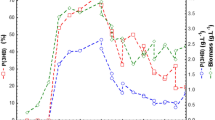Summary
Azotobacter vinelandii UWD produced very high molecular weight (MW) (approx. 4 million Daltons) poly-β-hydroxybutyrate (PHB) when grown in 5% w/v beet molasses medium. The polymer MW decreased as the beet molasses concentration was increased. Similar results were obtained in equivalent concentrations of sucrose (as raw sugar), but the polymer MW was not greater than 1.6 million. This difference was not caused by more severe oxygen-limitation in the beet molasses medium. It appeared that the nonsugar components of beet molasses promoted the formation of higher MW polymer. Fish peptone, a known PHB-yield-promoter in this organism, did not promote the formation of very high MW polymer.
Similar content being viewed by others
References
Anderson, A. J., and Dawes, E. A. (1990). Microbiol. Rev. 54, 450–472.
Anderson, A. J., Williams, D. R., Taidi, B., Dawes, E. A., and Ewing, D. F. (1992). FEMS Microbiol. Rev. 103, 93–102.
Budwill, K., Fedorak, P., and Page, W. J. (1992). Appl. Environ. Microbiol. 58, 1398–1401.
Byrom, D. (1987). Trend Biotechnol. 5, 246–250.
Chen, G. Q., Konig, K. H., and Lafferty, R. M. (1992). Effects of medium conditions on molecular weights of poly-β-hydroxybutyrate (PHB) and poly-β-hydroxyvalerate (PHB-co-HV) produced by strains ofAlcaligenese latus. In:International Symposium on Bacterial Polyhydroxyalkanoates, H. G. Schlegel and A. Steinbüchel, ed., pp. 408–409, Goltze-Druck, Göttingen, Germany.
de Koning, G. J. M., and Maxwell, I. A. (1993). J. Environ. Polymer Degrad. 1, 223–226.
Gerngross, T., Reilly, P., Stubble, J. O., Sinskey, A. J., and Peoples, O. P. (1993). J. Bacteriol. 175, 5289–5293.
Korsatko, W., Wabnegg, B., Braunegg, G., Lafferty, R. M., and Strempfl, F. (1983). Pharm. Ind. 42, 525–527.
Page, W. J. (1992a), FEMS Microbiol. Rev. 103, 149–158.
Page, W. J. (1992b). Biotechnol. Letters. 14, 385–390.
Page, W. J. (1992c). Appl. Microbiol. Biotechnol. 38, 117–121.
Page, W. J., and Rudy, B. (1993). Biotechniques 14, 228–233.
Page, W. J., and Knosp, O. (1989). Appl. Environ. Microbiol. 55, 1334–1339.
Page, W. J., Manchak, J., and Rudy, B. (1992). Appl. Environ. Microbiol. 58, 2866–2873.
Suzuki, T., Deguchi, H., Yamane, T., Shimizu, S., and Gekko, K. (1988). Appl. Microbiol. Biotechnol. 27, 487–491.
Author information
Authors and Affiliations
Rights and permissions
About this article
Cite this article
Chen, GQ., Page, W.J. The effect of substrate on the molecular weight ofpoly-β-hydroxybutyrate produced byAzotobacter vinelandii UWD. Biotechnol Lett 16, 155–160 (1994). https://doi.org/10.1007/BF01021663
Issue Date:
DOI: https://doi.org/10.1007/BF01021663




